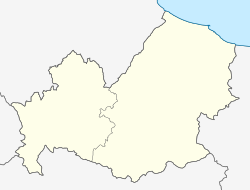
Campobasso is a city and comune in southern Italy, the capital of the region of Molise and of the province of Campobasso. It is located in the high basin of the Biferno river, surrounded by Sannio and Matese mountains.
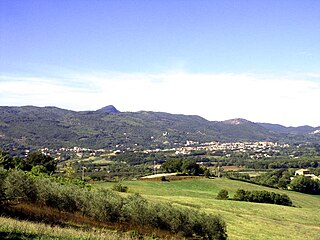
The province of Caserta is a province in the Campania region of Italy. Its capital is the city of Caserta, situated about 36 kilometres (22 mi) by road north of Naples. The province has an area of 2,651.35 square kilometres (1,023.69 sq mi), and had a total population of 924,414 in 2016. The Palace of Caserta is located near to the city, a former royal residence which was constructed for the Bourbon kings of Naples. It was the largest palace and one of the largest buildings erected in Europe during the 18th century. In 1997, the palace was designated a UNESCO World Heritage Site.

The province of Campobasso is a province in the Molise region of Italy. Its capital is the city of Campobasso. It covers an area of c. 2,941 square kilometres (1,136 sq mi) and has a total population of 223,871 (2017). There are 84 comuni in the province.

Mirabello Sannitico is a small town in the province of Campobasso, Molise, southern Italy. The population is about 2,100 inhabitants. It has an agrarian-based culture and history, dating back to at least the 12th century. Nearby towns include Campobasso to the northwest and Vinchiaturo to the southwest. The Tappino River flows on either side of the town on the north and south.

Macchia Valfortore is a town and comune in the Province of Campobasso, Molise, southern Italy.

Agnone is a comune in the province of Isernia, in the Molise region of southern Italy, some 53 km (33 mi) northwest of Campobasso. Agnone is known for the manufacture of bells by the Marinelli Bell Foundry. The town of Agnone proper is complemented with other populated centers like Fontesambuco, Villa Canale and Rigaini.
Terra di Lavoro is the name of a historical region of Southern Italy. It corresponds roughly to the modern southern Lazio and northern Campania and upper north west and west border area of Molise regions of Italy.

Piedimonte Matese is a comune (municipality) in the Province of Caserta in the Italian region of Campania, located about 82 km north of Naples and about 40 km north of Caserta.

Morcone is a comune (municipality) in the Province of Benevento in the Italian region Campania, located about 70 km northeast of Naples and about 25 km northwest of Benevento. The villages (Contrade) of Morcone include: Canepino, Cuffiano, Coste, Torre, Fuschi, Piana.
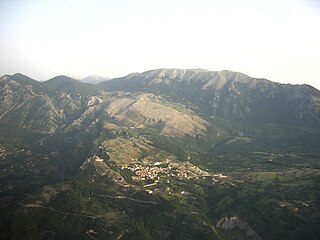
Pietraroja is a mountain comune (municipality) in the province of Benevento in Campania, southern Italy. It is approximately 50 km by car from Benevento, in direction north-west, 83 km from Naples in direction north-east and approximately 223 km from Rome in direction south-east.
Campochiaro is a comune (municipality) in the Province of Campobasso in the Italian region Molise, located about 20 kilometres (12 mi) southwest of Campobasso.
Colle d'Anchise is a comune (municipality) in the Province of Campobasso in the Italian region Molise, located about 14 kilometres (9 mi) southwest of Campobasso.

Guardialfiera is a comune (municipality) in the Province of Campobasso in the Italian region Molise, located about 30 kilometres (19 mi) northeast of Campobasso. It sits on a hilltop overlooking Lake Guardialfiera, which was created as a result of the damming of the Biferno river.
San Polo Matese is a comune (municipality) in the Province of Campobasso in the Italian region Molise, located about 20 kilometres (12 mi) southwest of Campobasso.
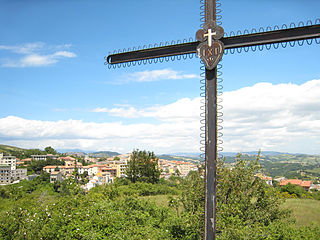
Frosolone is a comune (municipality) in the Province of Isernia in the Italian region Molise, located about 20 kilometres (12 mi) west of Campobasso and about 20 kilometres (12 mi) east of Isernia. It is one of I Borghi più belli d'Italia. Frosolone is known historically for the production of blades, including knives and scissors, and is home to a museum dedicated to the craft.
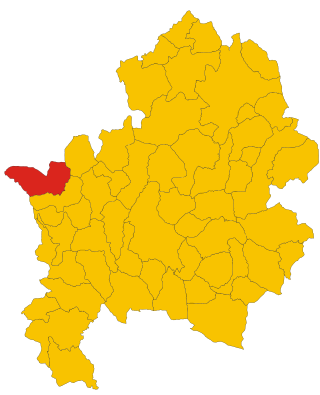
Pizzone is a comune (municipality) in the Province of Isernia in the Italian region Molise, about 50 kilometres (31 mi) west of Campobasso and about 20 kilometres (12 mi) northwest of Isernia near the Monti della Meta chain.
Poggio Sannita is a comune (municipality) in the Province of Isernia in the Italian region Molise, located about 30 kilometres (19 mi) northwest of Campobasso and about 25 kilometres (16 mi) northeast of Isernia. Poggio Sannita is on a promontory surrounded by the Verrino and Sente rivers, both mostly torrential in character, especially the latter, which dries up completely during the summer.

Roccamandolfi is a comune (municipality) in the Province of Isernia in the Italian region Molise, located about 25 kilometres (16 mi) southwest of Campobasso and about 15 kilometres (9 mi) southeast of Isernia.

The Matese is a chain of mountains in southern Apennines, southern Italy.

Campitello Matese is an Italian civil parish (frazione) and ski resort, part of the municipality of San Massimo in the province of Campobasso, Molise region.


